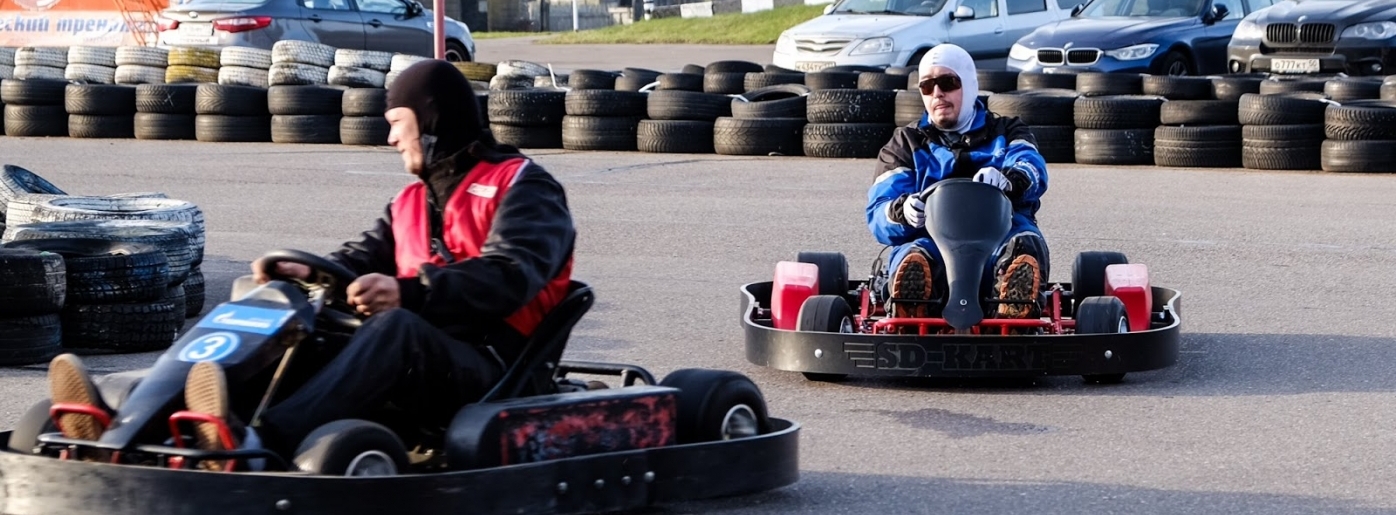Boris Vishnyakov is the board chairman of the Blind RaceSports and Health Club and the head of the department for the adaptation of motorsport for people with visual impairments. When I heard about this, it sounded unbelievable. Motor racing for visually impaired people appears to be futuristic or exists only in movies such as Scent of a Woman, where Al Pacino’s blind character cruises around the city at an enormous speed. But in Russia, it has already become a reality thanks to Boris Vishnyakov and his first co-driverNikolay Nikiforov. Boris told Vladimir Vaskevich, a Special Viewreporter, about this unique project.
A Kamaz truck hit me
“I’ve been fascinated by motorsport for a long time. I was interested in Formula 1 and, like many car racing fans, had a Schumacher poster on my wall. But, being partially sighted in one eye, I didn’t even consider this possibility for some time. However, I still bought a motorbike. It was in 2008.
In May 2011, my friends and I went to check the motorcade route for a motor show. At that time, my motorbike broke down, and I had to ride with my friend on his motorbike. A few minutes later, a Kamaz truck crashed into us. On impact, my helmet fell off, and I received multiple pelvic fractures and a traumatic brain injury. As a result of the accident, my eyesight began to deteriorate rapidly, and, by October 2011, I was completely blind. But I had to live somehow, and I realised that only my passion for motorsport could save me from depression.”
One day, Boris's friend Nikolay Nikiforov, who is now one of the leading instructors of the Blind Raceproject, invited him to participate in a small car rally.
“I accepted the invitation, but I didn’t want to idle and feel restricted so I actively started to develop the concept of blind driving. Many professional racers deliberately get training in blind driving. In Japan, there is a motorsport for normally sighted, in which they drive blindfolded and are guided by sound markers. On a rally, co-drivers are basically the driver’s eyes and tell them when to get ready to turn. When racing on challenging tracks at high speeds, it needs to be done in advance. So I decided to test it all on myself.”
That is how the training sessions with Nikolay began. The first ‘apparatus’, as Boris likes to say, was a quad bike given to him. He was practising in large open fields under the strict guidance of his friend. After a while, for the first time they were able to join a real race called Blind Fury.
“We had a Ural motorbike. Mine and Nikolay's goal, as well as that of the other teams, was to drive the given route within the shortest possible time period. The only difference between the participants was that the other drivers were blindfolded professional racers, but I couldn’t see for real. At that time, my brave co-driver and I managed to take first place, and I realised that it was possible and that we needed to develop this sport.”
Inclusive karting
Photo by Alexandra Mikhailova. In photo – Boris’s guide dog Joss.
Audio description: This is a colour photo. Two go-karts – single-seater open low vehicles without a bodyshell – are parked on asphalt by a fence. Boris is sitting in one of the karts leaning with his hands on the rear bumper, with his legs stretched forward. His face is covered with a balaclava. A black Labrador is sitting next to him. It is Boris’s guide dog named Joss. The dog is wearing a light-coloured muzzle, collar, harness with a large handle and has a retractable leash.
After their first victory, regular training began. Over time, the training process improved: Boris developed new training techniques for blind drivers and experienced co-drivers. For safety reasons, it was decided to switch to karting, though blind racing still preserved its spectacularity and vibe.
“A blind race team consists of a blind driver and a co-driver, who is either normally sighted or visually impaired or even someone with a musculoskeletal disorder. The co-driver leads the way in his kart, which is equipped with a loud sound beacon. A blind driver in his kart follows the sound coming from the co-driver's kart; his main task is to make sure that the leading kart is in front of him.
Blind racing is an inclusive sport where people with and without disabilities learn to interact effectively with each other on track to achieve a common goal. This type of interaction has proved to be much better during a race. Driven by the stimulus and vibe, blind people change drastically: they learn how to control not only a go-kart, but also their own lives. The key word here is ‘control’ since for many disabled people everything is decided by their relatives, mothers and fathers; however, on the race track, it all depends on you and your partner. Of course, things don’t work out right away, and training takes time. At first, the participants walk along the race track, then they study its model with their hands remembering every turn and only then get behind the wheel.
We practise twice a week. Since the beginning of the project, more than 30 blind drivers have taken part in test drives. Many professional motorsport drivers also tried our track blindfolded. All of them had the opportunity to try their hand, and some of them stayed with us as co-drivers. By now, we have managed to train five blind drivers, including myself. They are fully prepared for the blind race which our organisation is planning to hold late in the summer of 2019.”
According to Boris, the main problem is to find a specially equipped track. It should be enclosed and completely safe for everyone – drivers and co-drivers.
“Last year, we hired a track with the funding that we managed to raise from the Seven Lives concert at the Olympic Sports Complex, in which I also took part. Monthly rent for a race track is 25 thousand roubles. At the moment, there are almost no funds left, and it’s getting harder to provide regular training. But my colleagues and I are always looking for new sources of financing as we see the actual benefit of our work.”
Future plans
Photo by Alexandra Mikhailova
Audio description: This is a colour photo. Boris Vishnyakov is standing next to a red wooden building with a raised flag in his hand. Boris is dressed in a blue jumpsuit, white balaclava and is wearing dark glasses. A large blue flag with the Blind Race logo is waving above his head. Within the logo, there are two crossed black-and-white chequered flags against a white oval; in the centre between the flags, there are dark glasses in a white frame and a red five-pointed star underneath. The white inscription below says Blind Race, and at the top there are the same words in Braille.
Blind Race changes the lives of both blind and normally sighted participants. Visually impaired drivers become more independent, active and successful; they develop a huge desire to prove to themselves and others that a lot is possible beyond their blindness. As for normally sighted co-drivers, they also get unique experience and improve their driving skills: you still need to be able to dodge blind racers when they get a taste for speed and forget to slow down.
“I want motorsport for blind people to grow. It can be used as a unique rehabilitation technique for people who have lost their eyesight or have never even seen a car with their own eyes. After all, motorsport motivates people and adds flavour to their lives. In the future, we want to set up an inclusive motorsport federation, build an inclusive race rehabilitation centre, as well as organise and hold competitions in Russia and abroad. Around the world, there aren't any other similar mass sports for different categories of people. In Germany, driving schools annually organise charity drives, where blind people can try their hand at driving a sports car, though it’s nothing but a charity event.
There are individual records. For example, in England, Mike Newman alone accelerated to a speed of 323 kilometres per hour, but this, again, is an individual result. Mine and our organisation's idea is to make motorsport help vision or mobility impaired people, as well as normally sighted people to find competitive advantages in each other, achieve their goals together and become independent and successful.”
Boris also wants to take inclusive motorsport to a global level and organise competitions in different countries. He also hopes that classes of accident-free driving in the dark will be available for normally sighted drivers all over the world.
“We have many plans, and we are ready to implement them. The project is so unique and large-scale that there is a place for everyone. Our only condition is your willingness to change and improve. We are looking for like-minded people: blind drivers, co-drivers, photographers, designers, and, of course, sponsors. Currently, it is a non-commercial project that requires constant support. But we hope to find supportive people and organisations, and we'll continue our work anyway.”
Audio description: This is a colour photo. On a summer day, a column of fully equipped motorcyclists in helmets are riding along an alley – about ten motorcycles in total, some with pillion riders. Along the alley on the left, there are bushes and a tall cast-iron fence, with trees behind it. On the right, there is a lawn with yellow flowers. Cars are parked in the distance.
About the project: experts and participants
Sergey Mikheyev, a Blind Race driverand experienced racer, who was an accident-free driving instructor before losing his eyesight:
“I've been engaged in motorcycling and motorsport since I was a kid. I've repeatedly participated in Russian championships and won medals in motor rallying, motorbiking and aquabiking competitions. My biggest achievement is the Expedition Trophy motor rally. Back in 2005, my team and I travelled 18,800 km in two weeks from Murmansk to Vladivostok. But six years ago, I lost my vision, and my life seemed to be over. I coudn’t see anything, but every night I dreamed about driving. I kept thinking about how to make my dream come true and start driving again. One day in 2018, I met Boris and discovered that he was already driving blind and wanted to make it a mass sport. I was so inspired and happy when I finally got the chance to sit behind the wheel of a go-kart and press the gas and brake pedals. Once again, I had an opportunity to fulfil my potential. Now I practise regularly, share my experience with beginners and develop my blind driving techniques.”
Ernest Tsygankov, head of the Driving Excellence Centre, merited coach of Russia, Doctor of Pedagogical Sciences, Candidate of Technical Sciences, Professor at the Russian State University of Physical Education, Sport, Youth and Tourism, Academician:
“On the whole, it is a paradoxical project. Blind drivers should not be driving. However, if it takes place on an enclosed safe track, then why not? Moreover, as the managers of theBlind Race projectsay, this helps people become more confident and independent. The subject of training normally sighted drivers to drive blindfolded is very interesting. We practise it in our classes. Low-visibility conditions occur quite often, therefore, blind driving helps you learn to avoid accidents on the roads.”



Alexandr Saask, a narcologist, psychologist and Blind Race co-driver:
“I love experimenting in life and see blind racing as a challenge. As a psychologist, I'm interested in interacting with blind people, and I understand very well that we, normally sighted people, can learn a lot from them. That's why this project is especially valuable: we help people with vision impairments, and they teach us something in return. Together, we all evolve.”